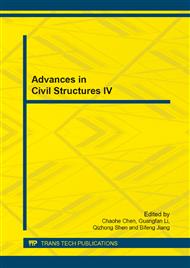p.1405
p.1410
p.1415
p.1419
p.1424
p.1430
p.1441
p.1449
p.1454
Experimental Method of Corrosion Fatigue Behaviors for Steel Strand under Corrosive Environment and Cycle Loading
Abstract:
A loading device was developed in this paper basing on corrosion experiments of conventional metal and cable through collecting previous research about cable stress corrosion. This newly developed device makes loading possible under low frequency alternating stress and environmental corrosion coupling. Through the different condition for the steel strands corrosion experiments show that the speed of steel strand corrosion in alternating stress load is faster than non-stress and static-stress in the same conditions. The co-influence of corrosion and stress to the ductility of strand, the influence of alternating load peak and frequency to corrosion velocity were respectively analyzed. Three groups of verification experiment results show that the plastic deformation effects caused by the tension are much larger than the corrosion. Corrosion velocity of the specimens that reached threshold value under tensile stress is 1.47 times faster than the other three peak load specimens. And the ductility is not sensitive to low frequency, the ductility of the specimen is associated with tension and corrosion.
Info:
Periodical:
Pages:
1424-1429
Citation:
Online since:
July 2014
Authors:
Keywords:
Price:
Сopyright:
© 2014 Trans Tech Publications Ltd. All Rights Reserved
Share:
Citation:


